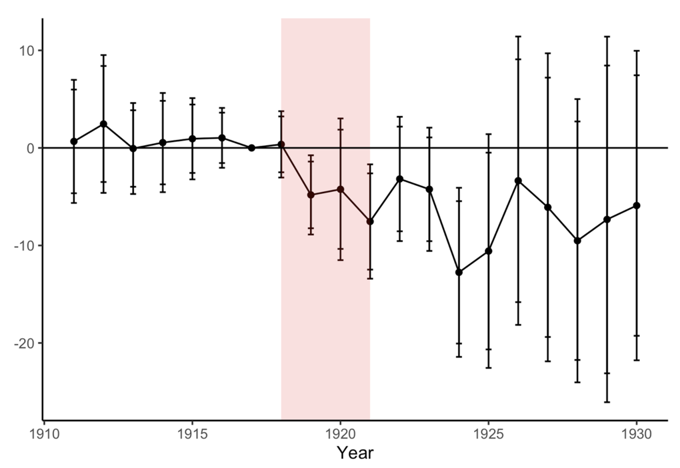Social distancing policies necessitated by Covid-19 – particularly the practice of working from home – may inhibit the exchange of ideas that generate inventions. This column looks to the Spanish flu that ravaged Japan from 1918 to 1921 to assess how face-to-face contact affects innovation. Patent applications for contact-intensive technologies significantly decreased in Japan during the pandemic, and did not fully recover once it ended. The decrease in patent requests was steepest for first-time applicants, suggesting that the loss of face-to-face contact is particularly detrimental in the early stages of an inventor’s career.
The exchange of ideas is key to the growth of knowledge (Lucas and Moll 2014). Various studies have demonstrated how important the knowledge exchanged through interactions with colleagues and mentors is to fostering innovation (e.g. Azoulay et al. 2010, Waldinger 2010 and 2012, Moser et al. 2014). Tacit knowledge can be transmitted especially effectively through face-to-face collaborative work (Saxenian 1996). The COVID-19 pandemic and its associated social distancing policies, such as work-from-home, have decreased interactions among inventors in the workplace. This may affect medium to long-term economic performance by impeding innovation.
To investigate the impact of human interaction on innovation activities, we focus on the Spanish influenza pandemic in Japan from 1918 to 1921, which drastically reduced opportunities for interaction between inventors (Inoue et al. 2022). The Spanish influenza pandemic is the most serious pandemic in modern history, accounting for 20–40 million deaths globally. Japan was seriously affected, with a death toll of 390,000. The mortality rate of Spanish influenza in Japan was higher among people aged 20–40; that is, among prime-aged workers (Hayami 2006). The Ministry of Home Affairs (1922) estimated that over 240,000 employed people lost their lives to the pandemic, a number that includes engineers and inventors. For example, from 1918 to 1921, 38 engineers from the Mitsubishi group companies died, including two engineers with registered patents. The damage to prime-aged workers reduced opportunities to communicate and exchange knowledge, thereby affecting innovation.
Using the Spanish influenza pandemic in Japan as an example, we explore differences in the intensity of human interaction across technological fields to identify the effect of human interactions on innovation. In other words, we categorised patent technology fields into communication-intensive and non-intensive fields with respect to their share of co-inventions in all patents before the pandemic. We defined patent technology classes with a large fraction of collaborative patents before the pandemic as collaboration-intensive technologies that required intensive interactions for invention. We then estimated the impact of the pandemic on the invention of collaboration-intensive technology using the difference-in-differences approach.
The main results are shown in Figure 1, which provides a graphical representation of the pandemic’s impact on innovations in collaboration-intensive technology by year. The red (highlighted) interval represents the Spanish influenza pandemic (1918–1921). While there was little difference in the number of patents registered in the pre-pandemic period between collaboration-intensive technology and other technologies, the number of patents registered in collaboration-intensive technology declined after 1919, when the pandemic began. The decrease in the number of patents registered in collaboration-intensive technology did not recover immediately after the end of the pandemic.

Overall, the estimation results indicate that the number of patent applications for collaboration-intensive technologies declined by 19% during the pandemic. Unlike the current COVID-19 pandemic, non-pharmaceutical interventions (NPIs) in Japan at the time were not restrictive, and the decline of innovation in collaboration-intensive technology was likely due to the loss of human interaction caused by influenza-related worker deaths.
This result has been robustly observed, bearing in mind that Japan was undergoing modernisation at the time and that some of the technologies in question were associated with traditional industries and made by craftsmen. These results are also robust considering that the pandemic occurred during WWI, when imports from Germany ceased and Japan began to internalise technologies related to industries once dependent on German imports.
Moreover, we find that the decrease in patent applications in collaboration-intensive fields during the pandemic was driven mainly by the reduction of new entries into innovation activities; that is, the number of patent applications by inventors who were first-time patent applicants declined significantly. Conversely, even in collaboration-intensive technology, the number of patent applications by incumbent inventors who had applied for patents before the pandemic did not decline significantly; rather, they shifted from co-inventions to sole inventions. These findings suggest that early in an inventor’s career, opportunities for technical guidance, communication, and knowledge exchange with seniors and colleagues through collaborative work are particularly important.
Our results imply that the decrease in human interaction caused by the inventors’ deaths decreased technological innovation activities that required intensive communication. This is consistent with the results shown by Berkes et al. (2020), who estimated the impact of NPIs on innovation during the Spanish influenza pandemic in the US. They observed that the number of patent applications did not decrease in cities with stronger NPIs, and concluded that this might be because the NPIs prevented an increase in inventor deaths and did not result in the loss of human interactions.
Our results suggest that exchanging ideas through human interaction is crucial for innovation. Social distancing policies during the COVID-19 pandemic reduced opportunities for idea exchange and knowledge spillover through face-to-face interactions. While Spanish influenza killed many people in the prime working years of their 30s and 40s, the COVID-19 pandemic disproportionately affected older people. As Wuchty et al. (2007) pointed out, most modern inventions are the result of collaborative research, highlighting the importance of communication with colleagues and collaborators. Maintaining opportunities for intellectual exchange, both online and off, is crucial to preventing the stagnation of intellectual production activities in the wake of the COVID-19 pandemic, especially between incumbents and newcomers.
Editor’s note: The main research on which this column is based (Inoue et al. 2022) first appeared as a Discussion Paper of the Research Institute of Economy, Trade and Industry (RIETI) of Japan.
This article first appeared on VoxEU on October 29, 2022. Reproduced with permission.





